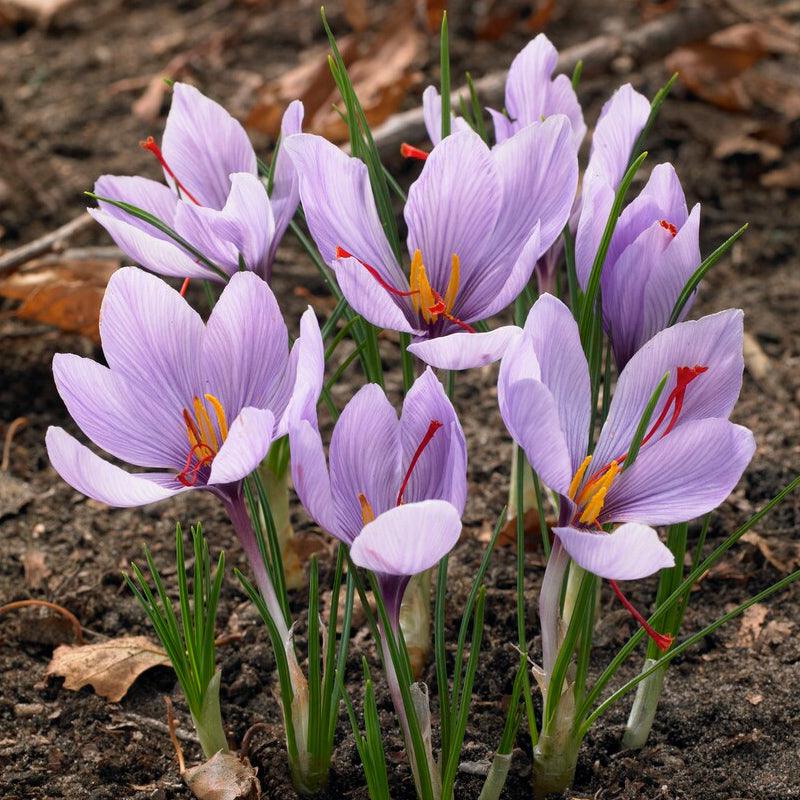Autumn Crocus vs Saffron Crocus – Safe or Deadly?

As the weather cools and gardens fill with autumn blooms, one question often confuses even seasoned gardeners: Is the autumn crocus the same as the saffron crocus? Despite their similar names and timing, these two flowers couldn’t be more different. One produces the valuable spice saffron, while the other—Colchicum autumnale—is dangerously toxic.
Understanding the difference between autumn crocus vs saffron crocus is essential for safe gardening and successful planting.
The Confusion: Two Plants, One Name
The term autumn crocus is often used for two unrelated plants that bloom in the fall:
- Saffron Crocus (Crocus sativus), a true crocus from the iris family (Iridaceae), produces the bright red threads used to make saffron, one of the world’s most expensive spices.
- Autumn Crocus (Colchicum autumnale), also called meadow saffron or naked ladies, belongs to the lily family (Colchicaceae) and contains toxic compounds that make it highly poisonous.
While both plants produce delicate, cup-shaped crocus flowers that bloom in the fall, they differ in their parts of the plant, structure, and safety.
Saffron Crocus (Crocus sativus): The True Crocus
The saffron crocus is a small, perennial bulb (technically a corm) planted inches deep in draining soil and full sun. Native to the Mediterranean, Crocus sativus flowers from summer to early fall and features slender purple petals with vivid red stigmas—the source of the culinary spice saffron.
Each flower yields only a small amount of saffron, which explains why it remains among the most expensive spices in the world. You can grow your own with high-quality bulbs like our Saffron Crocus (Crocus sativus).
Key features of Crocus crocus sativus:
- Belongs to the iris family
- Produces 3 deep red stigmas per flower (harvested as saffron)
- Thin, grassy leaves that appear alongside the blooms
- Safe and edible when correctly identified
Learn how to collect saffron threads safely in our guide on Harvesting from Saffron Crocuses.

Autumn Crocus (Colchicum autumnale): The Poisonous Look-Alike
The autumn crocus colchicum autumnale—also known as meadow saffron or naked ladies—is not a true crocus. Belonging to the family Colchicaceae, this plant produces larger lilac-pink flowers in the fall, long after its spring leaves have died back. Every part of this plant contains colchicine, a toxic compound that can cause severe poisoning if ingested.
Key traits of Colchicum autumnale:
- Not part of the iris family—it’s related to the lily family instead
- Larger flowers, usually lilac or pale purple
- Leaves emerge in spring, disappear before flowering
- Toxic parts of the plant, including bulbs and flowers
- Susceptible to fungal smut in poorly drained areas
Always label your crocus corms clearly to avoid confusion between true crocuses and their toxic impostors.
Spring Crocus: The Safe Decorative Option
If you love crocus flowers but don’t need saffron, the spring crocus (Crocus vernus) is a safe and colorful choice. These true crocuses bloom early in the year and brighten gardens with white, purple, or yellow petals. While beautiful, they don’t produce spice saffron.
Tips for Growing Saffron Crocus Safely
- Purchase corms only from trusted sellers.
- Plant Crocus sativus in full sun and draining soil.
- Space corms a few inches deep to prevent rot.
- Avoid planting near Colchicum autumnale or other toxic look-alikes.
- Check your growing zone before planting.
In Summary
When comparing autumn crocus vs saffron crocus, the rule is simple: Crocus sativus is the edible, true crocus, and Colchicum autumnale is the toxic imposter.
With careful labeling, proper planting in full sun and draining soil, and awareness of the family differences—you can safely enjoy fall blooming crocuses and even harvest your own saffron threads.



8 comments
I don’t know much about bees, but do know that most animals, including chickens, which I do own, are pretty good about instinctively knowing what is okay to eat, and what is not. I’m betting bees are the same.
Roxanne, I looked online and found this link to a helpful site, https://www.buzzaboutbees.net/Plants-Toxic-for-Bees.html. I do not see the crocus listed on this site. So I would say no, it is not toxic to bees.
Is colchicum toxic to pollinators? It’s planted next to wild oregano in my yard. Both flower in the fall and are frequented by local bees. My neighbors hives all died last year. We are a pesticide free neighborhood. Thank you!